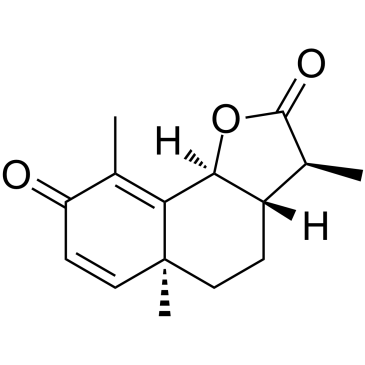Biotransformation of alpha- and 6beta-santonin by fungus and plant cell cultures.
L Yang, J Dai, J-I Sakai, M Ando
Index: J. Asian Nat. Prod. Res. 8(4) , 317-26, (2006)
Full Text: HTML
Abstract
One fungus, Abisidia coerulea IFO 4011, and suspended cell cultures of one plant, Asparagus officinalis, were employed to bioconvert alpha- and 6beta-santonin. Incubation of alpha-santonin with the cell cultures of the fungus afforded two products, 11beta-hydroxy-alpha-santonin (1, in 76.5% yield) and 8alpha-hydroxy-alpha-santonin (2, in 2.0% yield). And from 6beta-santonin, four major products (3, 4, 5 and 6) and four minor products (7, 8, 9 and 10) were obtained, including 8alpha-hydroxylated products in trace yields. Very interestingly, a skeletal rearrangement occurred and a guaiane product (13) formed in a very low yield when alpha-santonin incubating with A.officinalis cell cultures, while not in the case of 6beta-santonin as substrate. Among the obtained 15 products, 2, 7, 8, 9, 10 and 12 are new compounds. The fact of 8alpha hydroxylation of santonin enables the formation of 8,12-eudesmanolide instead of 6,12-eudesmanolide and some useful modification at C-8 position. In addition, these reactions would provide evidence for the biogenesis between different types of eudesmane and/or guaiane compounds in the plants in nature.
Related Compounds
| Structure | Name/CAS No. | Molecular Formula | Articles |
|---|---|---|---|
 |
Alpha-Santonin
CAS:481-06-1 |
C15H18O3 |
|
The human bitter taste receptor TAS2R10 is tailored to accom...
2013-01-02 [J. Neurosci. 33(1) , 201-13, (2013)] |
|
Reversal of cocaine-induced planarian behavior by parthenoli...
2008-04-01 [Pharmacol. Biochem. Behav. 89(2) , 160-70, (2008)] |
|
Diminutive effect on T and B-cell proliferation of non-cytot...
2013-02-01 [Eur. J. Med. Chem. 60 , 365-75, (2013)] |
|
Chemical modification of santonin into a diacetoxy acetal fo...
2006-05-12 [J. Biol. Chem. 281(19) , 13117-25, (2006)] |
|
Santonin-related compound 2 inhibits the nuclear translocati...
2012-01-01 [Biosci. Biotechnol. Biochem. 76(12) , 2360-3, (2012)] |